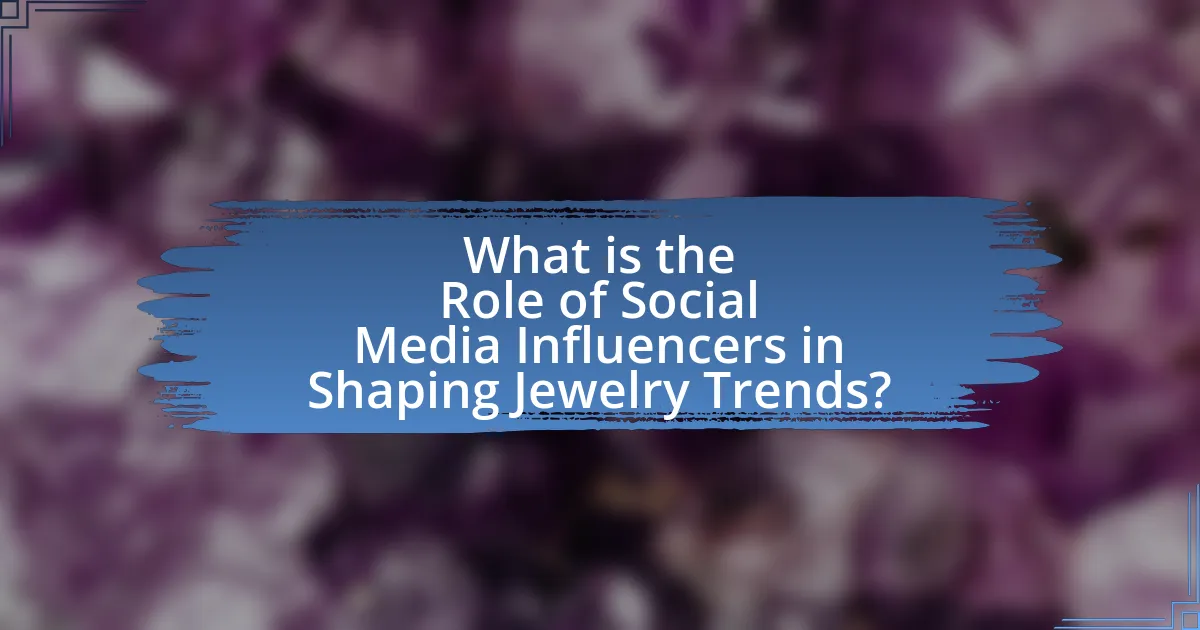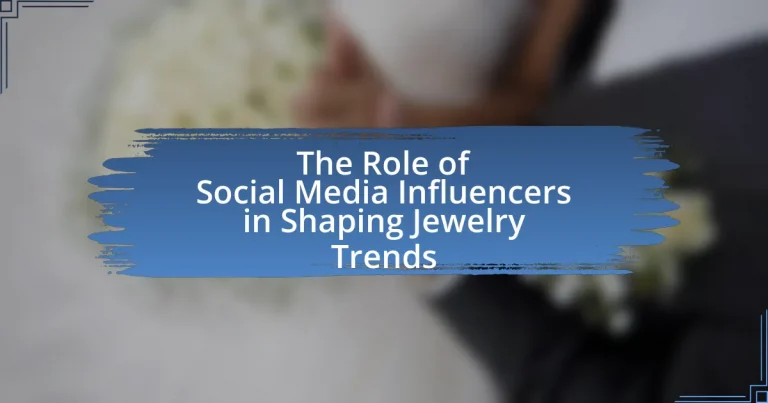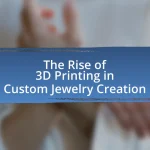Social media influencers play a pivotal role in shaping jewelry trends by utilizing their platforms to showcase styles and brands that resonate with their followers. Their influence significantly impacts consumer behavior, with studies indicating that a substantial percentage of consumers rely on influencer recommendations for purchasing decisions. The article explores how influencers promote jewelry through visual storytelling, authentic engagement, and strategic collaborations with brands. It also examines the differences between influencer marketing and traditional advertising, the effectiveness of various social media platforms, and the characteristics of successful jewelry influencers. Additionally, it addresses the challenges influencers face in a saturated market and the ethical considerations they must keep in mind while promoting jewelry.

What is the Role of Social Media Influencers in Shaping Jewelry Trends?
Social media influencers play a crucial role in shaping jewelry trends by leveraging their platforms to showcase styles, brands, and designs that resonate with their followers. Their ability to reach large audiences allows them to introduce new jewelry pieces and trends, often leading to increased visibility and sales for featured brands. For instance, a study by the Digital Marketing Institute found that 49% of consumers depend on influencer recommendations when making purchase decisions, highlighting the significant impact influencers have on consumer behavior in the jewelry market.
How do social media influencers impact consumer behavior in the jewelry market?
Social media influencers significantly impact consumer behavior in the jewelry market by shaping perceptions and driving purchasing decisions. Their curated content often showcases jewelry in aspirational contexts, leading to increased brand awareness and desirability. For instance, a study by the Digital Marketing Institute found that 49% of consumers depend on influencer recommendations when making purchase decisions. This influence is amplified by the visual nature of platforms like Instagram, where influencers can effectively demonstrate the aesthetic appeal of jewelry, thereby encouraging followers to emulate their style. Additionally, influencers often engage in partnerships with jewelry brands, creating a sense of authenticity and trust that can lead to higher conversion rates among their audience.
What strategies do influencers use to promote jewelry brands?
Influencers promote jewelry brands primarily through visual storytelling and authentic engagement with their audience. They utilize high-quality images and videos showcasing the jewelry in lifestyle contexts, which helps potential customers visualize the products in their own lives. Additionally, influencers often share personal stories or experiences related to the jewelry, creating a sense of authenticity and connection.
Collaborations with jewelry brands for exclusive collections or limited-edition pieces further enhance their promotional strategies, as these partnerships generate excitement and urgency among followers. Influencers also leverage social media features such as Instagram Stories, Reels, and TikTok videos to create engaging content that highlights the jewelry’s unique features and craftsmanship.
Moreover, influencers frequently employ discount codes or giveaways to incentivize purchases, making their promotions more appealing. According to a study by the Digital Marketing Institute, 49% of consumers rely on influencer recommendations for their purchasing decisions, underscoring the effectiveness of these strategies in driving sales for jewelry brands.
How does influencer marketing differ from traditional advertising in the jewelry industry?
Influencer marketing in the jewelry industry differs from traditional advertising primarily in its approach to audience engagement and authenticity. Influencer marketing leverages the personal connection and trust that influencers have with their followers, allowing for more relatable and genuine promotion of jewelry brands. In contrast, traditional advertising often relies on broad messaging through channels like television or print, which can feel impersonal and less engaging to consumers.
For instance, a study by the Digital Marketing Institute found that 49% of consumers depend on influencer recommendations, highlighting the effectiveness of influencer marketing in creating a more personal and trusted brand experience compared to traditional methods. This shift towards influencer-driven campaigns reflects a growing consumer preference for authenticity and relatability in brand interactions within the jewelry sector.
Why are social media platforms crucial for jewelry trendsetting?
Social media platforms are crucial for jewelry trendsetting because they provide a dynamic space for influencers and brands to showcase new designs and styles to a wide audience. These platforms facilitate real-time engagement, allowing users to share, comment, and promote jewelry trends instantly. For instance, a study by the Pew Research Center indicates that 72% of adults use at least one social media site, creating a vast network for trend dissemination. Additionally, platforms like Instagram and TikTok have algorithms that prioritize visually appealing content, making jewelry trends more accessible and shareable, thus accelerating their popularity.
Which platforms are most effective for jewelry influencers?
Instagram and TikTok are the most effective platforms for jewelry influencers. Instagram’s visual-centric design allows influencers to showcase intricate jewelry designs through high-quality images and engaging stories, leading to a 70% increase in engagement rates for jewelry-related posts. TikTok, with its short-form video content, enables influencers to create dynamic and creative showcases of jewelry, resulting in viral trends and a younger audience reach. According to a 2022 report by Statista, 67% of users on TikTok discover new products through influencer content, making it a powerful tool for jewelry marketing.
How do algorithms on social media affect jewelry visibility?
Algorithms on social media significantly influence jewelry visibility by determining which content is shown to users based on engagement metrics. These algorithms prioritize posts that receive higher likes, shares, and comments, thereby amplifying the visibility of jewelry brands and influencers whose content resonates with audiences. For instance, a study by Hootsuite in 2021 indicated that posts featuring visually appealing jewelry images and engaging captions tend to receive 50% more interactions, leading to increased exposure in users’ feeds. Consequently, jewelry brands that effectively leverage social media algorithms can enhance their reach and attract potential customers more efficiently.
What are the key characteristics of successful jewelry influencers?
Successful jewelry influencers possess authenticity, strong engagement with their audience, and a keen sense of aesthetics. Authenticity allows them to build trust, as followers are more likely to connect with influencers who present genuine content and personal stories. High engagement rates, measured through likes, comments, and shares, indicate that these influencers effectively communicate and resonate with their audience, fostering a loyal community. Additionally, a strong sense of aesthetics enables them to curate visually appealing content that showcases jewelry in innovative ways, attracting attention and driving trends. These characteristics are essential for influencing consumer behavior and shaping jewelry trends in the competitive social media landscape.
How does authenticity influence an influencer’s effectiveness in the jewelry niche?
Authenticity significantly enhances an influencer’s effectiveness in the jewelry niche by fostering trust and relatability among their audience. When influencers present genuine experiences and opinions about jewelry, their followers are more likely to perceive them as credible sources, leading to increased engagement and conversion rates. Research indicates that 86% of consumers consider authenticity important when deciding which brands to support, highlighting the direct correlation between an influencer’s perceived authenticity and their ability to influence purchasing decisions in the jewelry market.
What role does audience engagement play in an influencer’s success?
Audience engagement is crucial for an influencer’s success as it directly impacts their reach, credibility, and ability to drive sales. High levels of engagement, such as likes, comments, and shares, indicate that the audience is interested and invested in the influencer’s content, which can lead to increased visibility through social media algorithms. For instance, a study by the Digital Marketing Institute found that posts with higher engagement rates can achieve up to 10 times more reach than those with lower engagement. This enhanced visibility allows influencers to attract brand partnerships and sponsorships, further solidifying their position in the market. Therefore, effective audience engagement not only fosters a loyal community but also translates into tangible business opportunities for influencers.
How do influencers collaborate with jewelry brands?
Influencers collaborate with jewelry brands primarily through sponsored posts, product placements, and affiliate marketing. In these collaborations, influencers showcase the jewelry in their content, often sharing personal stories or styling tips to engage their audience. This method leverages the influencer’s reach and credibility to promote the brand, which can lead to increased visibility and sales. For instance, a study by the Digital Marketing Institute found that 49% of consumers depend on influencer recommendations when making purchase decisions, highlighting the effectiveness of such partnerships in the jewelry sector.
What types of partnerships exist between influencers and jewelry brands?
Influencers and jewelry brands engage in several types of partnerships, including sponsored posts, affiliate marketing, product collaborations, and brand ambassadorships. Sponsored posts involve influencers creating content featuring the brand’s jewelry in exchange for payment, which can significantly increase brand visibility. Affiliate marketing allows influencers to earn commissions on sales generated through their unique referral links, incentivizing them to promote the brand actively. Product collaborations involve influencers co-designing jewelry pieces with the brand, leveraging their personal style to attract their audience. Brand ambassadorships establish long-term relationships where influencers consistently promote the brand, enhancing credibility and fostering loyalty among their followers. These partnership types are effective in shaping jewelry trends by leveraging the influencers’ reach and authenticity.
How do influencers select the brands they collaborate with?
Influencers select brands for collaboration based on alignment with their personal values, audience demographics, and brand reputation. They assess whether the brand’s products resonate with their followers and fit their content style. Additionally, influencers consider the brand’s engagement metrics and previous collaborations to ensure a positive partnership. Research indicates that 70% of influencers prioritize authenticity and relevance when choosing brands, as these factors significantly impact audience trust and engagement.
What trends have emerged in jewelry due to influencer marketing?
Influencer marketing has led to several notable trends in jewelry, including the rise of personalized and custom pieces, increased popularity of sustainable and ethically sourced materials, and the prominence of statement jewelry that reflects individual style. Personalized jewelry has gained traction as influencers showcase unique designs that resonate with their followers, driving demand for custom pieces. Additionally, the focus on sustainability has prompted brands to highlight eco-friendly practices, aligning with consumer values. Influencers often promote bold, eye-catching designs, encouraging consumers to express their individuality through statement pieces. These trends are supported by data indicating that 70% of millennials are influenced by social media when making purchasing decisions, highlighting the significant impact of influencer marketing on jewelry trends.
How have influencer-led trends changed consumer preferences in jewelry?
Influencer-led trends have significantly shifted consumer preferences in jewelry by promoting unique styles and personalized pieces over traditional designs. Influencers leverage their platforms to showcase diverse jewelry brands and styles, leading consumers to seek out more individualized and trendy options. For instance, a study by the Digital Marketing Institute found that 49% of consumers rely on influencer recommendations for their purchasing decisions, indicating a strong correlation between influencer marketing and consumer behavior in the jewelry sector. This shift has resulted in increased demand for artisanal and sustainable jewelry, as influencers often highlight brands that align with ethical practices, further influencing consumer choices.
What are some examples of jewelry trends that originated from social media influencers?
Some examples of jewelry trends that originated from social media influencers include layered necklaces, statement earrings, and personalized jewelry. Influencers have popularized layered necklaces by showcasing multiple chains of varying lengths, creating a visually appealing look that encourages followers to replicate. Statement earrings gained traction as influencers highlighted bold, oversized designs that serve as focal points in outfits, driving demand for unique pieces. Personalized jewelry, such as name necklaces and initial rings, became a trend as influencers shared their customized pieces, emphasizing individuality and personal expression. These trends reflect the significant impact of social media influencers on consumer preferences in the jewelry market.
How can brands effectively leverage influencers to shape jewelry trends?
Brands can effectively leverage influencers to shape jewelry trends by collaborating with them to create authentic content that resonates with their audience. Influencers possess established trust and credibility, which can amplify brand messages and showcase jewelry in relatable contexts. For instance, a study by the Digital Marketing Institute found that 49% of consumers depend on influencer recommendations for their purchasing decisions. By selecting influencers whose personal style aligns with the brand’s aesthetic, companies can ensure that the jewelry is presented in a way that feels organic and appealing. Additionally, brands can utilize influencers to host giveaways or exclusive promotions, further engaging their followers and driving trend adoption.
What best practices should brands follow when working with influencers?
Brands should prioritize authenticity and alignment with influencers when collaborating. This means selecting influencers whose values and aesthetics resonate with the brand’s identity, ensuring that the partnership feels genuine to the audience. Research indicates that 92% of consumers trust recommendations from individuals over brands, highlighting the importance of credibility in influencer marketing. Additionally, brands should establish clear communication and expectations regarding deliverables, timelines, and compensation to foster a productive relationship. Engaging in long-term partnerships rather than one-off campaigns can also enhance brand loyalty and audience trust, as consistent messaging reinforces brand identity.
How can brands measure the success of influencer collaborations in the jewelry sector?
Brands can measure the success of influencer collaborations in the jewelry sector through key performance indicators (KPIs) such as engagement rates, conversion rates, and return on investment (ROI). Engagement rates can be assessed by analyzing likes, comments, shares, and overall interaction with the influencer’s content featuring the jewelry. Conversion rates can be tracked using unique discount codes or affiliate links, allowing brands to see how many sales were generated directly from the collaboration. Additionally, calculating ROI involves comparing the revenue generated from the influencer campaign against the costs incurred, providing a clear financial picture of the collaboration’s effectiveness. According to a study by Influencer Marketing Hub, businesses earn an average of $5.78 for every dollar spent on influencer marketing, highlighting the potential profitability of successful collaborations in this sector.
What challenges do influencers face in the jewelry industry?
Influencers in the jewelry industry face several challenges, including market saturation, authenticity concerns, and fluctuating consumer preferences. Market saturation occurs as numerous influencers promote similar products, making it difficult for any single influencer to stand out. Authenticity concerns arise when followers question the credibility of influencers who may not genuinely endorse the products they promote, leading to potential trust issues. Additionally, fluctuating consumer preferences can complicate marketing strategies, as trends in jewelry can change rapidly, requiring influencers to adapt quickly to maintain relevance. These challenges collectively impact the effectiveness of influencers in shaping jewelry trends.
How do market saturation and competition affect influencer effectiveness?
Market saturation and competition significantly diminish influencer effectiveness by reducing audience engagement and increasing content noise. In saturated markets, consumers encounter numerous influencers promoting similar products, leading to desensitization and decreased trust in influencer recommendations. A study by the Digital Marketing Institute found that 70% of consumers are more likely to trust peer recommendations over influencer endorsements when faced with multiple similar options. Additionally, heightened competition among influencers can lead to a dilution of brand messages, as influencers may resort to sensationalism or inauthenticity to stand out, further eroding their credibility. Thus, in a crowded marketplace, the unique value proposition of influencers is compromised, resulting in lower conversion rates and diminished impact on consumer behavior.
What ethical considerations should influencers keep in mind when promoting jewelry?
Influencers should prioritize transparency and authenticity when promoting jewelry. This includes clearly disclosing any paid partnerships or sponsorships to maintain trust with their audience. According to the Federal Trade Commission (FTC) guidelines, influencers are required to disclose material connections with brands, which helps consumers make informed decisions. Additionally, influencers should consider the ethical sourcing of the jewelry they promote, ensuring that materials are obtained responsibly and do not contribute to environmental harm or human rights violations. Research indicates that consumers are increasingly aware of ethical issues, with a 2021 survey by Nielsen showing that 66% of global consumers are willing to pay more for sustainable brands. By adhering to these ethical considerations, influencers can positively impact their audience and the jewelry industry.
What practical tips can jewelry brands use to engage with social media influencers?
Jewelry brands can effectively engage with social media influencers by establishing authentic relationships and offering value. Brands should identify influencers whose aesthetics align with their products, ensuring a genuine fit that resonates with their audience. Collaborating on creative campaigns, such as exclusive collections or giveaways, can enhance visibility and engagement. Additionally, providing influencers with personalized experiences, such as behind-the-scenes access or custom pieces, fosters loyalty and encourages authentic promotion. Research indicates that 49% of consumers depend on influencer recommendations, highlighting the importance of strategic partnerships in driving brand awareness and sales.


